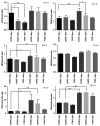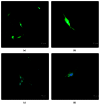A Comparative Evaluation of the Mechanical Properties of Two Calcium Phosphate/Collagen Composite Materials and Their Osteogenic Effects on Adipose-Derived Stem Cells
- PMID: 27239204
- PMCID: PMC4864572
- DOI: 10.1155/2016/6409546
A Comparative Evaluation of the Mechanical Properties of Two Calcium Phosphate/Collagen Composite Materials and Their Osteogenic Effects on Adipose-Derived Stem Cells
Abstract
Adipose-derived stem cells (ADSCs) are ideal seed cells for use in bone tissue engineering and they have many advantages over other stem cells. In this study, two kinds of calcium phosphate/collagen composite scaffolds were prepared and their effects on the proliferation and osteogenic differentiation of ADSCs were investigated. The hydroxyapatite/β-tricalcium phosphate (HA/β-TCP) composite scaffolds (HTPSs), which have an additional β-tricalcium phosphate, resulted in better proliferation of ADSCs and showed osteogenesis-promoting effects. Therefore, such composite scaffolds, in combination with ADSCs or on their own, would be promising for use in bone regeneration and potential clinical therapy for bone defects.
Figures









Similar articles
-
The effect of calcium phosphate composite scaffolds on the osteogenic differentiation of rabbit dental pulp stem cells.J Biomed Mater Res A. 2015 May;103(5):1732-45. doi: 10.1002/jbm.a.35303. Epub 2014 Sep 11. J Biomed Mater Res A. 2015. PMID: 25131439
-
Osteogenesis of adipose-derived stem cells on polycaprolactone-β-tricalcium phosphate scaffold fabricated via selective laser sintering and surface coating with collagen type I.J Tissue Eng Regen Med. 2016 Oct;10(10):E337-E353. doi: 10.1002/term.1811. Epub 2013 Aug 16. J Tissue Eng Regen Med. 2016. PMID: 23955935
-
Adipose-derived stem cell sheets combined with β-tricalcium phosphate/collagen-I fiber scaffold improve cell osteogenesis.Exp Ther Med. 2021 May;21(5):452. doi: 10.3892/etm.2021.9882. Epub 2021 Mar 1. Exp Ther Med. 2021. PMID: 33747187 Free PMC article.
-
Three-dimensional printed polycaprolactone-based scaffolds provide an advantageous environment for osteogenic differentiation of human adipose-derived stem cells.J Tissue Eng Regen Med. 2018 Jan;12(1):e473-e485. doi: 10.1002/term.2310. Epub 2017 Apr 11. J Tissue Eng Regen Med. 2018. PMID: 27599449
-
Electrospun composite poly(L-lactic acid)/tricalcium phosphate scaffolds induce proliferation and osteogenic differentiation of human adipose-derived stem cells.Biomed Mater. 2009 Jun;4(3):035002. doi: 10.1088/1748-6041/4/3/035002. Epub 2009 Apr 24. Biomed Mater. 2009. PMID: 19390143
Cited by
-
In Vitro Mechanical and Biological Properties of 3D Printed Polymer Composite and β-Tricalcium Phosphate Scaffold on Human Dental Pulp Stem Cells.Materials (Basel). 2020 Jul 8;13(14):3057. doi: 10.3390/ma13143057. Materials (Basel). 2020. PMID: 32650530 Free PMC article.
-
Single-dose local administration of parathyroid hormone (1-34, PTH) with β-tricalcium phosphate/collagen (β-TCP/COL) enhances bone defect healing in ovariectomized rats.J Bone Miner Metab. 2019 Jan;37(1):28-35. doi: 10.1007/s00774-018-0906-3. Epub 2018 Feb 1. J Bone Miner Metab. 2019. PMID: 29392472
-
Tumor protein p53-induced nuclear protein 2 modulates osteogenic differentiation of human adipose derived stem/stromal cells by activating Wnt/β-catenin signaling.Am J Transl Res. 2020 Oct 15;12(10):6853-6867. eCollection 2020. Am J Transl Res. 2020. PMID: 33194077 Free PMC article.
-
Bioactive calcium phosphate materials and applications in bone regeneration.Biomater Res. 2019 Jan 14;23:4. doi: 10.1186/s40824-018-0149-3. eCollection 2019. Biomater Res. 2019. PMID: 30675377 Free PMC article. Review.
-
Stratified-structural hydrogel incorporated with magnesium-ion-modified black phosphorus nanosheets for promoting neuro-vascularized bone regeneration.Bioact Mater. 2022 Feb 28;16:271-284. doi: 10.1016/j.bioactmat.2022.02.024. eCollection 2022 Oct. Bioact Mater. 2022. PMID: 35386320 Free PMC article.
References
-
- Jensen S. S., Terheyden H. Bone augmentation procedures in localized defects in the alveolar ridge: clinical results with different bone grafts and bone-substitute materials. The International Journal of Oral & Maxillofacial Implants. 2009;24(supplement):218–236. - PubMed
LinkOut - more resources
Full Text Sources
Other Literature Sources

